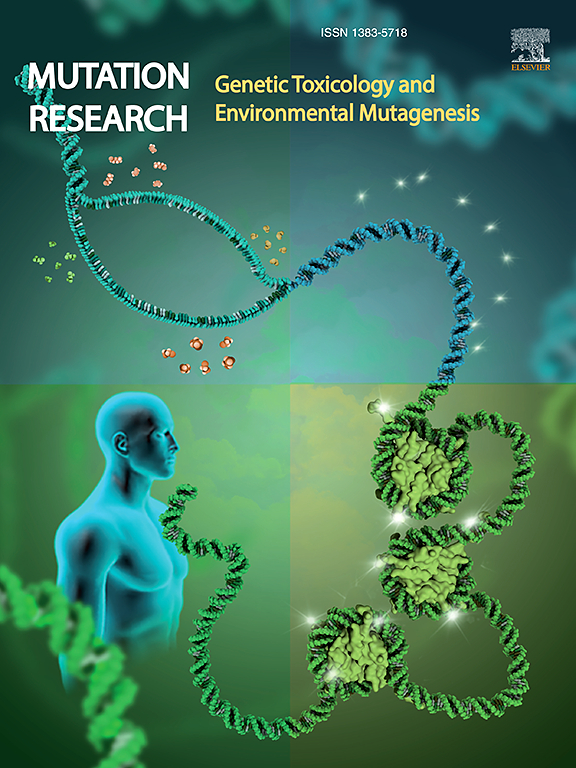Aminated polystyrene and DNA strand breaks in A549, Caco-2, THP-1 and U937 human cell lines
IF 2.5
4区 医学
Q3 BIOTECHNOLOGY & APPLIED MICROBIOLOGY
Mutation research. Genetic toxicology and environmental mutagenesis
Pub Date : 2025-03-05
DOI:10.1016/j.mrgentox.2025.503865
引用次数: 0
Abstract
Plastic is used extensively worldwide. However, plastic particles that are less than 1000 nm (i.e. nanoplastics) may be hazardous to human cells. Nanoplastics might be manufactured intentionally or be formed in the environment by degradation of larger plastic items. Ingestion and inhalation are the two most common routes of human exposure to nanoplastics, indicating that epithelial cells have direct exposure. However, immune cells will also interact with particles during tissue inflammation. An assessment of published studies suggests that polystyrene (PS) particles generate higher levels of DNA damage in immune cells compared to epithelial cells, although it has not been formally studied under the same experimental condition. To investigate this, we assessed cytotoxicity, oxidative stress and DNA strand breaks in lung epithelial (A549) cells, intestinal epithelial (Caco-2) cells, and two monocytes (THP-1 and U937) after exposure to amine-functionalized polystyrene particles (PS-NH2) with declared particle size of 240 nm. No cytotoxicity or intracellular reactive oxygen species production were found at concentrations up to 200 µg/mL. Exposure to PS-NH2 was associated with glutathione depletion in A549 cells. However, there was no increase in the level of DNA strand breaks, measured by the comet assay, in any of the cell lines under standard assay conditions. Diethyl maleate treatment was used to render cells susceptible to oxidative stress. By itself, diethyl maleate treatment led to approximately 50 % glutathione depletion and increased DNA strand breaks, but additional DNA damage was not observed in cells by PS-NH2 exposure in A549, Caco-2, THP-1 and U937 cells.
在A549, Caco-2, THP-1和U937人类细胞系中胺化聚苯乙烯和DNA链断裂
塑料在世界范围内被广泛使用。然而,小于1000 纳米的塑料颗粒(即纳米塑料)可能对人体细胞有害。纳米塑料可能是故意制造的,也可能是在环境中通过降解较大的塑料制品而形成的。摄入和吸入是人类接触纳米塑料的两种最常见途径,这表明上皮细胞直接接触纳米塑料。然而,在组织炎症期间,免疫细胞也会与颗粒相互作用。一项对已发表研究的评估表明,与上皮细胞相比,聚苯乙烯(PS)颗粒在免疫细胞中产生更高水平的DNA损伤,尽管尚未在相同的实验条件下进行正式研究。为了研究这一点,我们评估了暴露于胺功能化聚苯乙烯颗粒(PS-NH2)后肺上皮细胞(A549)、肠上皮细胞(Caco-2)和两个单核细胞(THP-1和U937)的细胞毒性、氧化应激和DNA链断裂。PS-NH2的粒径为240 nm。当浓度高达200µg/mL时,未发现细胞毒性或细胞内活性氧产生。暴露于PS-NH2与A549细胞中的谷胱甘肽耗竭有关。然而,在标准实验条件下,通过彗星实验测量的任何细胞系的DNA链断裂水平都没有增加。用马来酸二乙酯处理使细胞对氧化应激敏感。就其本身而言,马来酸二乙酯处理导致大约50%的谷胱甘肽消耗和增加的DNA链断裂,但在A549、cco -2、THP-1和U937细胞中,PS-NH2暴露未观察到额外的DNA损伤。
本文章由计算机程序翻译,如有差异,请以英文原文为准。
求助全文
约1分钟内获得全文
求助全文
来源期刊
CiteScore
3.80
自引率
5.30%
发文量
84
审稿时长
105 days
期刊介绍:
Mutation Research - Genetic Toxicology and Environmental Mutagenesis (MRGTEM) publishes papers advancing knowledge in the field of genetic toxicology. Papers are welcomed in the following areas:
New developments in genotoxicity testing of chemical agents (e.g. improvements in methodology of assay systems and interpretation of results).
Alternatives to and refinement of the use of animals in genotoxicity testing.
Nano-genotoxicology, the study of genotoxicity hazards and risks related to novel man-made nanomaterials.
Studies of epigenetic changes in relation to genotoxic effects.
The use of structure-activity relationships in predicting genotoxic effects.
The isolation and chemical characterization of novel environmental mutagens.
The measurement of genotoxic effects in human populations, when accompanied by quantitative measurements of environmental or occupational exposures.
The application of novel technologies for assessing the hazard and risks associated with genotoxic substances (e.g. OMICS or other high-throughput approaches to genotoxicity testing).
MRGTEM is now accepting submissions for a new section of the journal: Current Topics in Genotoxicity Testing, that will be dedicated to the discussion of current issues relating to design, interpretation and strategic use of genotoxicity tests. This section is envisaged to include discussions relating to the development of new international testing guidelines, but also to wider topics in the field. The evaluation of contrasting or opposing viewpoints is welcomed as long as the presentation is in accordance with the journal''s aims, scope, and policies.

 求助内容:
求助内容: 应助结果提醒方式:
应助结果提醒方式:


